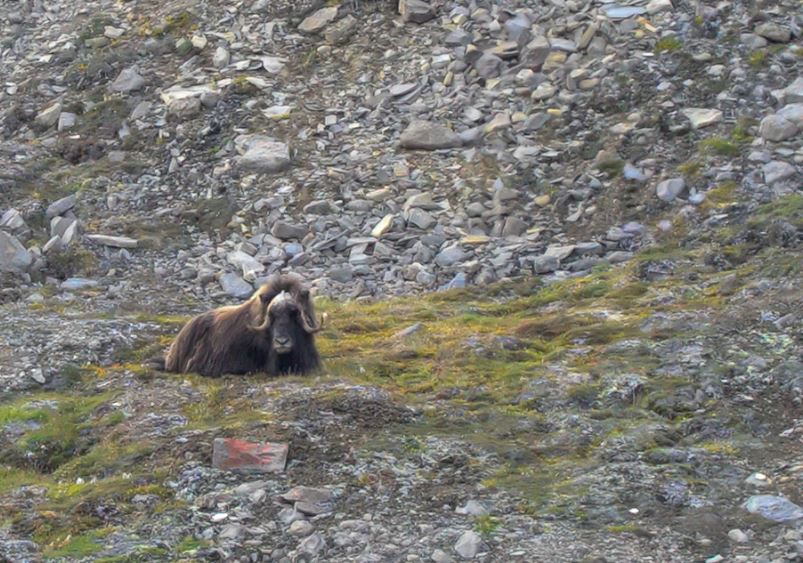In the company of bears
/We are running two to three expeditions per day from Rosehearty out in to the furthest reaches of Maxwell Bay. At the moment, a lot of ice is being drawn in to the bay, which is a mixed blessing. On the one hand, the ice carries with it the prospect of seals, walrus and polar bear. But the ice also brings tension, with the larger floes as big as or bigger than Rosehearty, long flat sections, often with submerged ledges that extend well beyond what we see on the surface, ledges that could contact rudder, shaft or propeller if they drift passed close enough. Big sheets started coming in about midnight. And that was when the call came out, bear on one of the floes, just off our port side. Guests and crew were awakened to share in the spectacle -- Nanuk under the midnight sun, having a rest, hitching a ride. Throughout the evening, the floes came, several with bear on them. The overnight watch teams as well as guests who refused to sleep held a vigil over the scene.
At 0700, the floes were too large and too close and so Markus, who had just come on watch, made the call to bring both engines and generators on line, and heave up anchor to avoid contact with the approaching slabs. “You’ve got two engines and three on the board,” Richie confirmed from the control room. The noise of the thruster, windlass and chain, startled the bear who up until this point, might have mistaken Rosehearty all in white as just another piece of ice floating with the current. Chef Artur was awake, doing his normal 10 minute stretch in the bridge before commencing his very long day in the galley. He told me later in an excited French Armenian accent “You should have seen dat bear when he heard the anchor. It was incredible."
Once safely re-anchored away from the ice, we launched the first tender. The mission was to scope out a waterfall about 4 miles from Rosehearty and to look for wildlife along the way. We sped off in flat water with Hugo at the helm, Ken pointing where he wanted us to go. The rest of scanned the ice and the shores, with binoculars, telephoto lenses and the naked eye. When doing 25 knots in the tender, a cold wind becomes an icy blast very quickly. Exposed skin tingles at first, then burns, and throbs, unless you cover it. Hugo sported his balaclava, ski goggles, thick ski gloves.
At first, we thought we were looking at dirty ice -- rocks and mud picked up either when the berg is still part of a glacier or when a slab is grounded temporarily by the tide. But the dirt became a shape and the shape turned into a seal. Hugo killed the motors and everyone on board became silent – hopeful and reverent at the same time. We used the paddles to inch our way closer. The seal had a clear view of us, lifting his head, watchful. To our delight, the seal stayed put and allowed us to enjoy the views through binoculars and zoom lenses. “It’s a bearded seal,” Ken explained. I read later that bearded seals are the largest of the Arctic seals and can grow to 450kg. They forage usually in bays for clams, octopus and squid, and in open water can dive as deep as 400 meters. They sport long, even bushy whiskers and a heavy jaw, from which their name is derived (erignathus barbatus). Apparently, the males sing and can be heard from as far as 20 kilometers away. When we were about a 100 meters away, the seal had had enough of our presence and flopped into the icy water and swam away.
In the northern most part of Maxwell Bay’s western arm, there are large sections of moist earth, turned green with arctic grasses, lichens and plants. By now we had become familiar with this type of terrain and what might be found here and so we were not surprised when Ken pointed towards the fertile slope and said, “Now that is a beautiful specimen.” A lone musk ox . We all tried to zoom in and shoot but Paul pretty much summed it when he said, “I’m going to have quite a few photos of black dots. I hope my friends believe me when I tell them the dot is a musk ox.” Where there are musk ox, there are usually wolves, said Ken. We strained and squinted, imagined a pack of wolves working in unison to avoid the horns and hoofs in their struggle to bring the beast down.
After our return, more ice sheets entered the anchorage. Ethan and I used long boat hooks to push the smaller sections of ice away from the hull. For the larger sheets, we had to use thruster or drop an extra shot of chain and use engines to get out of the way. Lenka, who was in the master cabin, hear crunching and watched with consternation as she saw boat hooks prodding the ice. Germain, our ice pilot and Hutch poured over an ice chart and radar sat images that had just been published. Neither was smiling. To our east, the entire 60-mile width of Lancaster Sound showed the color orange with reference numbers inside the “egg”. This translated to 7/10 total coverage, 1/10 first year ice, 7/10 thick first year ice, vast floe size. Rosehearty was effectively blocked from traveling east or west. “My concern,” said Germain, “is that with the southeast winds, we will have a lot of ice coming into this bay. We either try to get out now, or we have to be prepared to wait for a couple of days to leave.” With winds in the sound at 25 knots, gusting 30 knots, we opted to stay put for at least 24 hours until the next ice report was issued.
Hutch sent the RIB to sound the anchorage behind a nearby island. The island we thought might make a nice shield against ice being dragged in from the sea. Mark and I approached, checking depths and looking for ice. “What’s that on the side of the hill?” Mark said. “An indistinct lump broke up the otherwise flat slope on the hill. “could be a boulder or an Inuksuk,” I said. The binoculars were already on his eyes. “It’s a bear,” he said, “Have a look.” On a wide patch of rocky ground the bear came in to view. And then something quite magical happened. One shape became two and we suddenly realized we were not looking at a lone male bear but instead were in the company of a mother bear and her adolescent cub. We radioed the boat, shut off the motors and hoped that the sight of the tender and the approaching Rosehearty would not spook the animals. Mark and I watched as everyone assembled on the foredeck. Hutch approached slowly with Rosehearty, and once in position, radioed Ethan to walk the anchor and chain out, rather than do the normal free wheel drop. We have found that nothing scares wildlife away quicker than a 460 kg anchor and 3 shots of chain rumbling out of the box. The bears seemed indifferent. The cub edged towards the shore, while the mother sat on her haunches on higher ground. She lifted her nose and sniffed to determine our status. At the high tide line was a long line of brown seaweed. The young bear picked at it, swallowed some. Both Mark and I had the impression that the young bear would have preferred seal or Narwhal but at mother’s insistence was required to choke down the ursine equivalent of spinach. As soon as Rosehearty was anchored, we picked up our team on the side door and moved slowly towards the beach. The wind blew from behind us and edged us toward the bears. Ken instructed Mark to approach from the side, not head on. In silence we drifted in. Radios were turned off. Cameras whirred. The female bear looked on. We were almost to the beach, truly in the company of bears.
Nanuk under the midnight sun — Photo by Catherine Carr
Photo by Hugo
Photo by Richie
Photo by Dr. Paul
Photo by Lenka
Photo by Richie
Photo by Richie
Photo by Ken Burton
Parting shot!! by Richard
Photo by Ken Burton













